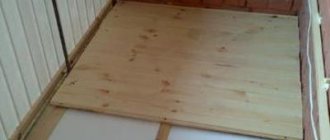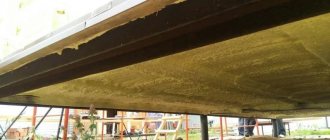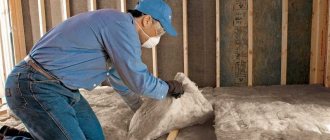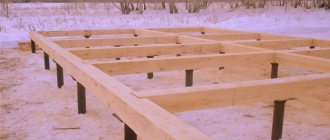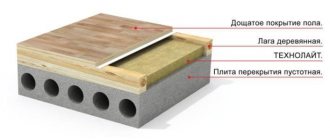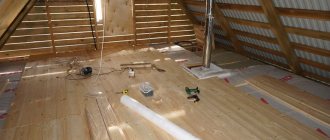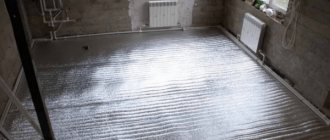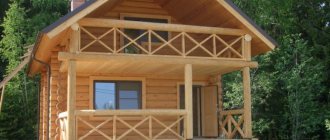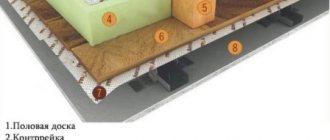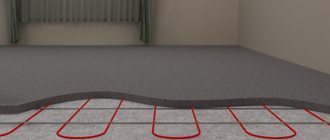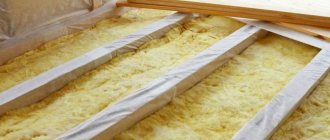Insulation with modern materials has a lot of disadvantages, from the release of unsafe substances to the high cost of thermal insulation, so more and more often builders and self-developers are turning to old recipes. For example, it is quite possible to insulate the floor with sawdust in a private house. With a very good heat preservation effect, and most importantly, without the risk of getting poisoned by toluene released from polystyrene foam.
Sawdust will serve as insulation no worse than polystyrene foam.
Is it possible to insulate the floor with sawdust?
The use of natural materials for insulating residential premises always encounters certain concerns that arise among owners of private houses for quite objective reasons. The main fears and prejudices when using sawdust in a house for insulation can be listed in several points:
- Firstly, any lumber, and especially a mixture of dry shavings and sawdust, burn very well, or rather, they smolder in one avalanche, which is impossible to extinguish with water in a private house;
- Secondly, even sawdust treated with fire retardants has always been an ideal place for rats and mice to settle in the house. In addition to all the inconveniences associated with being in the vicinity of rodents, the animals can completely destroy and damage the insulation of the floor;
- Thirdly, the sawdust layer is prone to caking and self-compaction during long-term storage. Accordingly, the thickness of the thermal insulation decreases and the efficiency of insulation decreases.
Most of the above can actually happen, from the fire of the insulation layer under the floor in the house to the appearance of mice. But only if you do not take special protective measures, the cost of which is not so high compared to the price of modern insulation materials based on foam plastic or mineral wool.
The smell of sawdust insulation lingers in the house for another couple of months
For example, it makes sense to insulate the floor with sawdust in a wooden house. It will still be necessary to treat the structure with fire retardants and antifungal agents, and the use of cheap and accessible sawdust will not in any way affect the price and safety of a private home.
Important! Any bulk types of insulation laid under wooden floors release huge amounts of microparticles and dust into the air. Of all the possible options, microdust from sawdust is considered the safest in comparison with what is produced by polystyrene foam granules, mineral wool or expanded clay.
Even in a brick or frame house, using sawdust to insulate the floor does not create additional problems. For example, protection against rodents can be ensured by laying a metal mesh over the insulation layer, and it is quite possible to prevent caking or dusting by adding binders to the sawdust composition. And one more huge plus - any insulation with sawdust in a private house can be done on your own at minimal cost.
Advantages and disadvantages of sawdust insulation
The undoubted advantage of chip lumber is its absolutely low price and availability. You can get them at any carpentry shop or get them yourself by cutting shavings from the surface of a dry beam with a small or large plane. Moreover, the material used is environmentally friendly, natural and “warm”, which cannot be said about some types of insulation from the store. This plus ensures a safe life in the house for allergy sufferers, asthmatics and small children. Using sawdust you can not only insulate your house, but also minimize the content of chemicals in it.
The main disadvantage of the material is flammability. The chips are dry, light and can quickly ignite when a source of ignition appears. The second disadvantage of insulation is that it is an excellent place for rodents to live. In order to prevent the breeding of mice and rats in the floor, the shavings are pre-treated with antiseptic solutions of copper sulfate or boric acid.
To achieve the most “warm” effect, craftsmen recommend mixing shavings with materials such as clay, lime, cement, and gypsum. The compositions are easy to prepare, taking into account the proportions. The complexity of the technological process for insulation is the final drawback of the method, but it can be solved with outside help.
What tools and materials will be needed
Floor insulation with sawdust is carried out in several ways; accordingly, in addition to the sawdust-shaving mass, various auxiliary materials and binders will be required. First of all, you will need to buy:
- Fire retardant chrome protectant;
- Copper sulfate.
Today this is the best pair against fungus and fire.
To insulate wooden log floors, sifted sawdust is used with the addition of PVA-based binder and wood glue. In addition, you will need a vapor barrier film, a stapler and tape for gluing the panels.
Concrete floors in a private house are most often filled with sawdust concrete. You will need cement, liquid soap and a primer.
The tools you will need are a small concrete mixer for preparing sawdust concrete. To level the insulation layer you will need a plaster rule and a spatula.
In other cases, a metal container, a bayonet shovel and a sprayer spraying liquid binder will be sufficient.
What sawdust is best to use for insulation?
It is believed that the best material for thermal insulation is sawdust from dried larch. This type of sawdust is difficult to buy, so it is easier to cut it yourself on a peeling machine at your nearest carpentry shop.
Oak and aspen wood is ideal. Beech and birch do not withstand prolonged contact with moisture and rot, so they are not used for insulating a private house under a screed.
Any sawdust is suitable for insulation
Poplar wood is perfect for bulk types of insulation. It is the softest of all species, produces large sawdust without splinters, the layer is very soft and warm. If the floors in a private house are made with ventilation, then the poplar backfill can last for a couple of decades without any problems.
Advice! You should not rely on the natural qualities of wood; in any case, the sawdust mass, be it larch, oak or pine, must be treated with disinfectants.
In addition, to insulate the floor in a private house, you can only use fresh, dried material that has not been stored in the open air for more than two weeks. Otherwise, along with sawdust, you can easily introduce a worm bug or fungus under the floor.
Insulating the floor with sawdust: disadvantages
Natural material has some disadvantages. Everyone knows that organic insulation often harbors bugs or rodents. If installed incorrectly, rodents may actually appear in the material, but the same thing can happen with any other thermal insulation material. How to protect yourself from this? Use roofing felt and modern thermal insulation materials. Reliable protection is the laying of roofing felt and the use of advanced modern thermal insulation materials, which are created on the basis of granulated sawdust. These insulation materials, in addition to the sawdust that is included in their composition, contain adhesive based on fire retardant antisetic and carboxymethylcellulose, which increases durability and strength.
The use of the latest technologies in the production of modern sawdust insulation has allowed manufacturers to successfully solve the problems that arise when using this type of material, minimize losses and improve performance. One of the important characteristics of sawdust insulation is non-flammability, which cannot be said about sawdust itself, which is known to be a fire hazard. Light weight makes it convenient and easy to transport and install.
All the advantages mentioned above indicate the advantages of sawdust insulation in the process of floor insulation. If we take into account that, compared to other insulation materials, sawdust has an optimal quality-to-price ratio, the benefits become obvious.
At first glance, sawdust seems like waste material. However, this is not so; they will serve well as insulation. The main thing is to choose the right material; it is best to go to the forest for it yourself, prepare the floor and carry out insulation according to the instructions. Then no problems should arise, and your home will be warm and cozy.
Preparing for insulation
Preparatory work for joist floors, which are usually the majority in private homes, comes down to thoroughly cleaning the insulated space, sealing cracks and holes, and treating the board lining with antiseptics and stains.
Dry mix of sawdust and cement
In any case, before laying sawdust insulation, it is necessary to check the subfloor for water leakage from the street and for properly functioning vents. In a private house, a floor without ventilation and additional insulation is doomed to rot.
Types of heat insulators made from sawdust
Scheme of insulation of wooden coverings with sawdust.
Both sawdust in its pure form and building materials made from it can act as heat insulators. There are a number of building materials used for insulation, consisting of sawdust:
- wood concrete;
- wood blocks;
- sawdust concrete;
- pellets.
It is worth considering each type of sawdust insulation produced separately.
Arbolit
This insulation is lightweight concrete based on cement with chemical additives and organic fillers - 90% of the volume is wood chips. Arbolite was standardized and developed in the 60s of the 19th century. The composition of organic fillers is crushed rice grass, crushed wood, flax or hemp. Wood concrete is used as a noise and thermal insulation material in the form of a finished slab or a finished building block. The main advantage of wood concrete is the high strength of the connection between the sawdust in the slab, excellent adsorption of sound waves, ease of processing and non-flammability. The main disadvantage is that the insulation has low resistance to moisture.
Wood blocks
The material is made from cement, sawdust and copper sulfate. The sawdust is treated with copper sulfate and then dried. Before laying, sawdust is mixed with cement in proportions of 1:8. The mixture is poured into the walls in steps: waterproofing is carried out, boards are nailed, and the mixture is poured. After each backfill, it is necessary to compact the mixture thoroughly; shrinkage and insulation depend on the consistency and density of the mixture. Due to the fact that sawdust is laid wet, it retains water, and the cement undergoes a setting process, which is how a wood block is formed. The result is an excellent material for thermal insulation.
Sawdust concrete
The insulation is made in this way: sawdust, sand and cement are combined until a homogeneous mass is obtained, water is added to the mixture in small doses, everything is mixed. By squeezing the mass in your hand, you should get a fairly strong lump that does not release water - this is how readiness is checked. The resulting insulation in the form of blocks is a fire-resistant and warm material. In terms of the quality of thermal protection, this material is better than solid brick; among other things, it is the most optimal in terms of sanitary and hygienic characteristics. Sawdust concrete requires reliable protection from moisture both inside and outside, since it is made of organic matter - sawdust.
Compressed granular or sawdust pellets
Granules are an excellent material for thermal insulation that can solve many problems. An antiseptic, cheap and fire-resistant heat insulator consists of glue based on carboxymethylcellulose, sawdust and an antiseptic fire retardant.
Scheme of insulating the floor with sawdust.
How to insulate a floor with sawdust in a private house
Before you begin laying sawdust thermal insulation, the wood pulp must be prepared, sequentially treated with a fire retardant mixture dissolved in water, dried and re-applied with a spray solution of vitriol. All this is dried in a draft under a canopy.
Floor insulation with sawdust and lime
This method is used for a wooden floor in a private house with a strip foundation. Typically, the logs are additionally hemmed along the lower edge with boards, which avoids direct contact with the sand bedding of the foundation of a private house.
Before backfilling, the floor must be hemmed and primed.
Next, we lay the film over the sheathing and the joists, fix it with a stapler to the beams, and glue the joints with tape. Warming the floor in the house begins with filling a mixture of the finest sawdust, mixed the day before with slaked lime in a ratio of 1:10. The backfill mass should occupy approximately 1/3 of the height of the underground space. High-quality backfill has a texture reminiscent of river sand.
The next layer is laid from shavings; this insulation layer occupies 2/3 of the height. Large twisted spirals and shavings should be pressed and compacted as much as possible. All that remains is to sprinkle the large shavings with fine dust once again. To prevent backfill insulation from releasing dust into the air, the surface is sprayed with an aqueous PVA solution and covered with geotextiles.
After laying the insulation, there should be a free space of 4-5 cm high between the floorboards and sawdust.
Floor insulation with sawdust and cement
Thermal insulation based on cement laitance can be done in two ways - prepare a solution of sawdust concrete for pouring the floor in the house and form ready-made blocks from which to lay out a layer of insulation.
For a garage or summer kitchen, or any unheated private household with a cement-sand screed on the floor, the best option would be to fill it with sawdust concrete. To do this, the sawdust mass is impregnated with a weak solution of liquid soap and mixed with the finished cement mortar in a volume ratio of 1:1.
The mass is spread on the floor and leveled over the surface with a spatula. The sawdust mixture does not spread well, so you have to place large portions on the concrete and break them with a hand tamper. After setting, the insulation layer is covered with a cement screed.
The second method of insulation is simpler; in this case, the amount of cement laitance in the batch is reduced by three times, in addition, PVA and plasticizers are added to the solution. Such a mass can be immediately laid out between the joists, if the floor in a private house is wooden, or blocks can be formed to insulate the concrete base.
Laying out the blocks should be done with overlapping seams in three layers. There is no screed for insulation; floorboards or laminate are laid.
Floor insulation with sawdust and clay
This is the most labor-intensive type of work, and the bulk of time and effort is spent on preparing the sawdust-clay mass. It is quite difficult to mix clay and sawdust in a mixer, so you have to use a metal trough and a bayonet shovel.
The sawdust is also moistened with soapy water, and the clay is diluted to the state of sour cream. All this is mixed in small portions, a solution of boric acid is added and laid out to dry in the courtyard of the house. Chopped straw is often added to the mix to make the insulation dry faster. The larger the area of the private home area, the thinner the sawdust mats for insulation can be made.
Thoroughly dried sheets are laid under the floor, always with wet rubbing of the blocks along the edges. Large gaps between the sheets are simply rubbed with a damp mixture of sawdust and clay. The insulation is done in one layer and dried again for at least another two weeks.
Insulation materials
248 votes
+
Vote for!
—
Vote against!
When thinking about building their own home, sooner or later every owner faces the question of choosing materials. And this applies not only to the construction of the structure itself, but also to the products from which the thermal insulation will be installed. The modern insulation market can offer a huge range of different materials, ranging from mineral wool to extruded polystyrene foam. But even the most expensive material does not guarantee complete heat retention, without unnecessary losses, while the budget will be significantly reduced due to its purchase. Many experts increasingly began to return to long-known, but gradually forgotten methods of thermal insulation of buildings. And first of all, we are talking about insulating the floor, ceiling and walls using sawdust or shavings. The article will talk about insulating a house with sawdust.
- Insulation with clay and sawdust
Features and types of sawdust
- Sawdust is the name given to particles of processed wood obtained by sawing; outwardly they look like fine dust.
- There is also a type of wood waste called shavings. The differences between them are in the manufacturing method; to produce shavings, wood must be planed or drilled; it also has a slightly larger size (approximate length 3-5 cm) than sawdust.
- Sawdust can also be of different fractions from 5 mm to 3 cm. The length depends on the technological processes of the woodworking industry, that is, what type of tool is used in each specific case.
- This is an environmentally friendly material, which, in addition to its low cost (on average, the price per bag ranges from 10-70 rubles, and they are often given free at sawmills) has a lot of other advantages. Among the more significant ones are the excellent thermal insulation and sound-absorbing properties and the relatively low specific gravity of the product. Most wood scraps are made from hardwoods such as spruce, pine or ash.
Ceiling insulation with sawdust
Issues of ceiling insulation should be addressed in private housing construction made of any material, be it a wooden house, or made of brick or foam blocks. After all, it is through the ceiling that significant heat loss occurs, on average about 20%. The most cost-effective way to insulate a structure is to lay a thick layer of sawdust.
Of course, stacking wood products is not an easy task. Before proceeding with the actual installation, extensive preparatory work will have to be carried out. First of all, this procedure is aimed at protecting against fire, since wood in almost any form is extremely flammable, that is, it ignites easily and has a long burning time.
Required materials and tools:
- sawdust of small and large fractions;
- sand, clay or slag;
- lime and copper sulfate (or boric acid);
- material for the substrate (corrugated cardboard or any other breathable materials, that is, with good vapor permeability);
- sealant and polyurethane foam;
- fire retardants, water repellents and antiseptics for wood (if the ceiling boards are not protected from mold and fungi, fire and water, then a comprehensive preliminary treatment should be carried out);
- construction stapler and staples for it.
Stages of work
All work begins with protecting the ceiling beams and boards from possible adverse factors. As a rule, high-quality buildings are built from processed material. But if such a procedure was missed for some reason, then it must be done now.
How to properly process
Wood structures are protected comprehensively, in compliance with the following sequence:
- antiseptic agents that prevent putrefaction and protect against insects;
- fire-retardant preparations for resistance to fire and elevated temperatures;
- water repellents, which prevent moisture from entering the wood structure and washing out previously applied products, while at the same time, water-repellent substances should not prevent excess moisture from leaving the boards.
It is necessary to ensure that all products are compatible with each other. It is advisable to choose a product line from one manufacturer.
Laying the substrate
- After the required protective work has been carried out, all seams, joints and existing cracks should be sealed with foam and sealant. Polyurethane foam is used in places with large gaps; small cracks and crevices are sealed with acrylic, polyurethane, thiokol or silicone-based sealants. Although the bitumen composition is good for roofs, it cannot withstand high temperatures, but in principle no one prohibits its use.
- It is not recommended to just foam all the cracks, since due to the special structure of the foam it ignites very quickly, which is extremely dangerous in cases of thermal insulation of the structure with sawdust.
- In addition to the cracks in the ceiling, all other holes in the roof structure are also sealed. This is necessary so that precipitation does not fall on the insulation or the thermal insulation layer does not rise during gusts of wind. At the same time, spaces should be left through which air will flow, such as small attic windows. This measure is needed to dry the laid sawdust, as well as to ventilate it.
- Do not forget about trimming the protruding parts of the foam flush with the ceiling beams, otherwise in the future there will be voids in these places through which heat will escape and cold will enter. When all the holes in the ceiling are sealed, the sealant and foam are dried and leveled, you can lay the underlay. This procedure is necessary to ensure that fine dust from sawdust does not fall off the ceiling and create additional dust in the house. After all, no matter how carefully all the cracks are sealed, the possibility of their occurrence cannot be ruled out, so you should be safe in advance.
- The substrate must necessarily have parapermeable properties, otherwise warm air and steam, rising upward, will be trapped between the boards and materials, forming unnecessary condensation, and in the future, the development of bacteria, mold and rot, that is, failure of the entire structure, is possible.
- Any cardboard will do, from old boxes, packaging, etc., as long as it is dry.
- Ceiling boards are cleaned of dirt and dust and cardboard sheets are laid on them in several layers. The material should be overlapped by 15-30 cm so that sawdust does not accidentally get between the seams. Next, all the joints of the substrate are secured with staples; it is advisable to place them at a short distance from each other and make sure that all layers of cardboard are captured. Thin cardboard is best laid in 2-3 layers. The edges in contact with the beams are also secured with staples, and then sealed around the entire perimeter with sealant or polyurethane foam.
Selection of sawdust and methods of filling it
- The wood-based material should be selected dry or slightly damp, with no odors unusual for wood. It is best to pre-treat sawdust with solutions of fire retardants and antiseptics. When the mass dries, you can add 10% lime (fluff) and a little copper sulfate (or borax) to it, mix the composition thoroughly.
- There are several main methods for installing thermal insulation from wood chip industry waste. Sawdust can be poured either in pure dry form or mixed with cement and diluted with water (or initially wet material is used). You should work with the cement mixture as quickly as possible, since it hardens within 30-60 minutes, after which it will no longer be possible to compact it thoroughly.
Dry method
- For the dry method, it is recommended to pour sawdust in two layers. The first consists of a larger fraction or chips, and the second is filled with the smallest products. This measure will help avoid unnecessary dust in the house, which can arise due to filling only small, fine-grained products.
- Also, large sawdust cannot be compacted properly, and this must be done so that the heat-insulating layer does not allow heat to pass through, but retains it and even releases it back into the room.
- The coarse-grained material is covered with a layer of 10-15 cm and compacted; a layer of fine sawdust of the same thickness is placed on top of it and is also carefully pressed and trampled down.
- It is allowed to wet the layer a little for better shrinkage. In general, insulation with a thickness of 20-30 cm is sufficient. It is also recommended to lay ash, slag (necessarily completely burnt and cooled), sand or clay on top. This, firstly, will help preserve heat, and, secondly, will prevent the appearance of rodents and the development of mold.
Insulation with sawdust and cement
- Method of installing thermal insulation from wet sawdust with cement. To implement it, you need to stock up on wood-based material that has been stored for at least a year and has a slightly damp composition. At the same time, be sure to make sure that the sawdust does not have pockets of bacteria, fungi or mold.
- The ratio of chips, water and cement in the composition should be as follows: 20:3:2. In this case, it is best to add the solution in small portions in order to have time to use it. The dry components (sawdust and cement) are thoroughly mixed, and then water is gradually added, while the mixture continues to be stirred.
Advice: do not forget that the shavings must be pre-treated with various protective agents and mixed with lime, as well as copper sulfate. If such procedures have not been carried out in advance, then all this should be added to the prepared solution.
- The prepared insulation is poured between the floor beams onto a substrate or a layer of sand and compacted. The result should be insulation up to 5-10 cm thick. The mixture sets well and after complete hardening you can move on it without fear; it will crunch a little, but should not sag.
- Once the insulation has been installed to allow normal walking on the surface of the attic, it is best to install a deck of boards or other hard material. If frequent movements are not planned, then it is permissible to leave the roof in this condition (that is, without covering the insulating layer).
Floor insulation with sawdust
Insulating the floor with sawdust is an environmentally friendly solution that is also beneficial from an economic point of view, at the same time, this method allows you to create conditions for comfortable living, reduce heat loss and reduce heating costs.
- The sawdust used for floor insulation, as well as in the case of ceiling insulation, requires preliminary treatment against rodents, insects and the development of pathogens. For this purpose, special ready-made products or slaked dry lime and broken glass are used. You just have to be very careful about the composition to which glass is added. Most often, such a remedy is abandoned in favor of lime fluff and copper sulfate.
- The difference between floor insulation and ceiling insulation is that adding insulator that has shrinked into the floor structure is extremely problematic. This means that you should take care in advance and choose a method in which the mixture will not decrease in volume over time, which will ultimately lead to heat loss. In practice, this means that when arranging protection for the floor from freezing, sawdust is most often filled with sawdust that is not free-flowing, but mixed with various components and subsequently hardened.
- In order to prepare such a composition, it is necessary to add gypsum or cement to the sawdust. The following proportions are recommended: 85% of the mass is sawdust, 5% gypsum and 10% fluff lime or lime dough (which requires twice as much as dry lime). Do not forget that gypsum sets almost instantly, in order to slightly extend the life of the solution, gypsum can be replaced with cement, which, although it has a short lifespan, is still longer than that of a gypsum mixture.
- There is no need to dry the sawdust before mixing; you should prepare the insulation in small portions and mix all the components thoroughly. If the sawdust seems too dry, add a little water or milk of lime to the mixture. You can check the degree of readiness by squeezing the prepared mixture in your hand - if the lump does not crumble or spread, but holds its shape well, then the mass is ready.
- If the floor is insulated in an already used room, then the floor covering is dismantled, the ceilings are treated with antiseptic primers and moisture-resistant mastics, and then a backing made of vapor barrier material or film is laid.
- The prepared mixture of sawdust is carefully placed on top of the substrate and carefully compacted; the layer height is about 10 cm for the first floor and up to 20-30 cm for the interfloor ceiling, which should be taken into account, since this is the height to which the floor on the second floor will rise.
- When the mass is thoroughly compacted, it must be left to harden; the ripening period ranges from 2 weeks to a month.
Insulation with clay and sawdust
- A method of insulating a floor using a mixture of sawdust and clay. This method involves covering the substrate with a waterproof material, for example, thick polyethylene film (150-220 microns). It is precisely because of this feature that this technique is not suitable for ceiling insulation, since the design of the thermal insulation of the ceiling must contain breathable materials that easily allow water vapor to pass through and do not form condensation, which invariably leads to the formation of mold and rot.
- The film can be glued to a concrete base or fixed to a wooden surface. This will help keep it in place without mixing. The substrate is laid overlapping to avoid leakage of the solution, since the mixture of clay and sawdust will be in a fairly fluid state.
- For kneading you will need clay and water. The consistency of the solution should resemble liquid sour cream. That is, for 100 liters of water, 5-6 buckets of clay (it is important to regulate the density, depending on the material). To mix the mixture with sawdust, it is best to use a concrete mixer or a construction mixer. It is recommended to knead gradually, take 1-2 buckets of liquid clay and add sawdust until the mass thickens.
- This type of insulation should be applied in a uniform layer up to 10 cm thick. You can press it with a flat, even object with a large surface area (for example, a wide wooden board or shield).
- It takes 7 to 15 days for the mixture to harden, depending on temperature and humidity. When drying, cracks may form on the surface, which can easily be repaired with the same clay. Also, if such insulation is expected to be present in a damp room, it should be covered with moisture-resistant mastic. Then you can lay the wooden flooring and use the floor.
Dry method of laying sawdust
- It involves the installation of a raised floor. Sawdust is treated with fire retardants and antiseptics. This can be done by pouring protective solutions from a watering can onto the dry mass and mixing thoroughly so that every particle is covered with the product. After the insulation is prepared, the construction of the subfloor begins.
- To do this, all wooden products (joists, floor beams) are also coated with protective compounds. After that, a subfloor made of boards is installed on the base, and a layer of waterproofing is laid on it. Sawdust with a thickness of at least 10 cm is poured over the hydrobarrier. It is recommended to spill the sawdust with lime milk (lime diluted to a very liquid state). This will increase the resistance of thermal insulation to biological decomposition.
- It is worth considering that it is not allowed to insulate the floor with sawdust for subsequent screeding. Since such a layer has low strength and can cause significant shrinkage. Before applying the topcoat, you need to give time for excess moisture to come out, this is approximately 2-4 days. It is also possible that during the allotted time the sawdust will shrink by 2-3 cm. That is, in the future you should either add an additional layer, or at the backfilling stage you should immediately make its thickness within 12-14 cm, which is more optimal. In addition, slight shrinkage is possible over the next year.
- If the sawdust does not have good waterproofing and ventilation (the gap between the finished floor and the insulation layer), then they will soon lose their heat-shielding properties. Therefore, you need to think about this at the planning stage of the floor design.
Insulation of walls with sawdust
- The most difficult procedure is considered to be wall insulation, since it is necessary to erect a frame, which is filled with sawdust and compacted manually. For laying in a frame wall, coarse sawdust should be prepared. If dry installation is intended, then the thermal insulation material must be well dried and not contain excess moisture.
- The mixture is prepared from wood chips, lime, gypsum or cement (since the gypsum-based material will have to be worked very quickly and prepared in small portions), as well as with the addition of antiseptics to the composition. The well-mixed mass is moistened, poured into the prepared frame and thoroughly compacted to avoid further subsidence. The gypsum or cement in the composition over time draws out all the available moisture and binds the mass into a monolith.
- Between the wall and the insulation there should be a waterproofing material with vapor-permeable properties. The effectiveness of insulation and the degree of shrinkage depend on the quality of compaction and the density of the backfill. In a poorly compacted layer, voids may appear, which means that heat loss will inevitably occur in these places in the future.
- The mixture is laid in layers of 20-30 cm and compacted, then a new layer of the same height is added and again carefully pressed and so gradually fills the entire space. The thickness of the insulation varies depending on the purpose of the building and its location (climatic zone). So, in a house for seasonal residence, a layer of 15 cm is enough, but if it is a permanent house, then 25-30 cm of wall insulation is required to maintain a comfortable temperature. The frame can be made of wooden boards with a section of 100x50 mm.
- The mass in the wall begins to harden after 1-2 weeks, and finally sets within a month. Throughout this period, it is advisable to maintain a relative air humidity of no more than 60-70% and a temperature within 20-25 degrees, as well as arrange regular ventilation of the room. If voids appear during this time, it is better to fill them immediately and only then proceed to further finishing of the walls.
Tips for insulating a house with sawdust
- In order for thermal insulation made from sawdust to serve as long as possible, not be attacked by rodents and to be reliably protected from the development of mold and bacteria, it is necessary to add 5-10% dry lime to the total mass.
- When insulating wooden buildings with sawdust, fire safety requirements must be observed. That is, in places where the chimney, chimney pipes or electrical wiring pass, it is necessary to take additional protective measures - arrange dividing areas in which instead of sawdust there will be any other non-combustible material, hide the wires in special boxes or metal tubes, line the locations of sockets and switches with non-flammable substances.
- If buying cardboard seems like an expensive procedure, then you can find a free way to deliver it. All you have to do is go to the nearest shops and supermarkets and ask them for unwanted boxes. In addition, you can get sawdust completely free of charge: ask your neighbors who are involved in construction, or go to the nearest sawmills and sawmills; it happens that they just give away the waste for pickup.
- A year or two after laying dry sawdust, they shrink a little, and for better insulation it is recommended to add a small additional layer.
- Fresh sawdust contains substances that prevent the cement from bonding well with water, which means that the prepared mixture will not have the necessary qualities. To avoid this, it is recommended to use sawdust that has rested for at least 2-3 months. If construction needs to be done urgently, then liquid glass can be added to the composition.
- If we compare sawdust with other insulation materials, then mineral wool is closest to them in terms of heat-insulating and noise-absorbing properties. The consumption of these two materials is approximately the same, but wood chips are a natural product, environmentally friendly and safe.
- The main disadvantages of wood chip products are their flammability and rodent damage. But these shortcomings are easily eliminated by using various protective drugs. In addition, for the same purposes, it is practiced to add lime, gypsum or cement to the composition, copper sulfate and boric acid. Such masses are too tough for rodents, and also do not ignite and do not support combustion.
- It is best to carry out work on laying thermal insulation in the summer season, since it is at this time that the mixture can be thoroughly dried, and, therefore, in the future, avoid problems with the development of all kinds of bacteria and mold formations.
- Sawdust varies in size, and the smaller it is, the more water will be needed to wet the mixture. And when fresh shavings are used, more cement will be required, which will significantly reduce the thermal insulation properties.
- The main advantages of wood processing products include availability, efficiency, durability and ease of installation.
- When purchasing sawdust, you should opt for medium-fraction material, since it is very difficult to work with small products due to the large amount of dust, and the large fraction does not have good thermal insulation properties. It is best if the waste comes from boards that have undergone preliminary chamber drying, but if such sawdust is very difficult to obtain and there is waste from logs of natural moisture, then the shavings must be placed under a canopy and slightly dried, without covering them in any way.
- To insulate a house, pine sawdust is the best option, as it already contains resin that repels bugs and rodents. For insulating other outbuildings, including bathhouses, waste from deciduous trees (for example, ash) is suitable, but it should be mixed with antiseptics or ash.
- It is better not to purchase sawdust that is too dirty; if there is debris, it is either selected by hand or sifted through a construction sieve.
- When adding copper sulfate or borax to the composition, do not forget that this is a toxic chemical substance and be sure to take all necessary safety measures, first of all, this applies to protecting your hands and respiratory tract.
- If the insulation mixture is being prepared for thermal insulation of a bathhouse, then it is better not to use copper sulfate, since when heated it emits toxic fumes.
Sawdust is used in the construction of residential buildings and commercial buildings. This is an economical and environmentally friendly material. It is used to insulate roofs, walls and floors, both in its pure form and with the addition of various components. We can say with complete confidence that this is an excellent way to increase heat and sound insulation, but only if certain rules are followed.
Recommendations and common mistakes
Often owners of private houses and households try to simplify the work and perform insulation with granules made from pressed sawdust. The thermal insulation turns out to be weak; it is necessary to increase the layer of sawdust granules and accordingly change the height of the floors in the house. Today you can buy ready-made material from sawdust and straw, pressed at high temperatures without binders. These are usually large blocks that can be easily cut in any direction. Such blocks cannot insulate the floor, only the walls and ceiling of the house.
Another problem is the self-compaction of the poured mixture. Often the layer of sawdust poured between the heaped joists sags by almost half. The reason for this can only be moisture that has got on the material. Therefore, sawdust is always dried under pressure, often tamped and compacted. If there is no opportunity and time in a private house for the natural shrinkage of sawdust insulation, then you can sew mats from fabric and fill them with small sawdust and straw, which are used to insulate the floor. Approximately according to the same scheme as is done when laying rolls of mineral fiber.
Insulation of floors with low underground
This method is labor-intensive and is carried out in a wooden house where there is no basement under the floor or the height of the building itself is small. The work is being carried out in stages:
- The old floor covering is being dismantled. If these are wooden boards, they must be numbered for successful and quick installation upon completion of the work;
- Wooden supports are being inspected. All rotten and fungus-affected supports are replaced with new bars of the same size. The structure must be treated with an antiseptic and thoroughly dried;
- A solid beam is mounted to the lower edge of the existing joists on both sides. It is screwed on with galvanized screws. The timber will serve as the basis for the lower part of the double floor;
- Raw boards are prepared for the subfloor. Their length is equal to the distance between the wooden logs minus 1–2 cm. This will allow the boards to be laid freely;
- Next, the prepared boards are installed by laying them on the logs as usual. It is not recommended to tightly fit the wooden material to each other, just as it is not recommended to screw them to the joists;
- A waterproofing layer is laid on the prepared flooring. This can be a regular polyethylene film or a special membrane. In places where there is a joint, it is overlapped and secured with construction tape. An allowance is also made on the walls, up to 15 cm high;
- Laying the insulating mixture. It is laid directly on the hydrobarrier in layers of 10 cm, followed by compaction and drying. If there is no time to dry each layer, then the mixture is laid in one layer, but with mandatory drying at the end. It can last up to 1 week, depending on climatic conditions;
- The height of the insulation should be less than the height of the logs in which it is laid. The difference in height serves as a ventilation layer;
- A second layer of hydrobarrier is laid on top of the dried insulation;
- The final stage is the organization of a finished floor in a wooden house.
